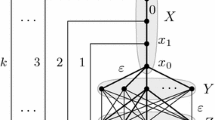Abstract
We introduce new classes of graphs to investigate networks that guarantee constant delays even in the case of multiple edge failures. This means the following: as long as two vertices remain connected if some edges have failed, then the distance between these vertices in the faulty graph is at most a constant factor k times the original distance. In this extended abstract, we consider the case where the number of edge failures is bounded by a constant l. These graphs are called (k, l)- self-spanners. We prove that the problem of maximizing l for a given graph when k > 4 is fixed is NP-complete, whereas the dual problem of minimizing k when l is fixed is solvable in polynomial time.We show how the Cartesian product affects the self-spanner properties of the composed graph. As a consequence, several popular network topologies (like grids, tori, hypercubes, butterflies, and cube-connected cycles) are investigated with respect to their self-spanner properties.
Research partially supported by Italian MURST project ‘Teoria dei Grafie e Appli- cazioni’, and by the Deutsche Forschungsgemeinschaft under grant Wa 65410-2
Access this chapter
Tax calculation will be finalised at checkout
Purchases are for personal use only
Preview
Unable to display preview. Download preview PDF.
Similar content being viewed by others
References
F. S. Annexstein. Fault tolerance in hypercube-derivative networks. Computer Architecture News, 19(1):25–34, 1991.
F. S. Annexstein, M. Baumslag, and A. L. Rosenberg. Group action graphs and parallel architectures. SIAM J. Comput., 19(3):544–569, 1990.
J. Bruck, R. Cypher, and C.-T. Ho. Fault-tolerant meshes with small degree. SIAM J. Comput., 26(6):1764–1784, 1997.
S. Cicerone and G. Di Stefano. Graphs with bounded induced distance. In Proceedings 24th International Workshop on Graph-Theoretic Concepts in Computer Science, WG’98, pages 177–191. Springer-Verlag, Lecture Notes in Computer Science, vol. 1517, 1998.
S. Cicerone, G. Di Stefano, and D. Handke. Survivable Networks with Bounded Delays. Technical Report, Konstanzer Schriften in Mathematik und Informatik n. 81, University of Konstanz, Germany, February 1999.
R. Cole, B. M. Maggs, and R. K. Sitaraman. Reconfiguring arrays with faults part I: Worst-case faults. SIAM J. Comput., 26(6):1581–1611, 1997.
M. R. Garey and D. S. Johnson. Computers and Intractability: A Guide to the Theory of NP Completeness. W H Freeman & Co Ltd, 1979.
D. Handke. Independent tree spanners: Fault-tolerant spanning trees with constant distance guarantees (extended abstract). In Proceedings 24th International Workshop on Graph-Theoretic Concepts in Computer Science, WG’98, pages 203–214. Springer-Verlag, Lecture Notes in Computer Science, vol. 1517, 1998.
M.-C. Heydemann, J. G. Peters, and D. Sotteau. Spanners of hypercube-derived networks. SIAM J. on Discr. Math., 9(1):37–54, 1996.
A. Itai, Y. Perl, and Y. Shiloach. The complexity of finding maximum disjoint paths with length constraints. Networks, 12:277–286, 1982.
F. T. Leighton. Introduction to parallel algorithms and architectures: arrays, trees, hypercubes. Morgan Kaufman Publishers, 1992.
F. T. Leighton, B. M. Maggs, and R. K. Sitaraman. On the fault tolerance of some popular bounded-degree networks. SIAM J. Comput., 27(6):1303–1333, 1998.
D. Peleg and A. A. Schäffer. Graph spanners. J. of Graph Theory, 13:99–116, 1989.
A. L. Rosenberg. Cycles in networks. Technical Report UM-CS-1991-020, Dept. of Computer and Information Science, Univ. of Massachusetts, 1991.
T.-Y. Sung, M.-Y. Lin, and T.-Y. Ho. Multiple-edge-fault tolerance with respect to hypercubes. IEEE Trans. Parallel and Distributed Systems, 8(2):187–192, 1997.
Author information
Authors and Affiliations
Rights and permissions
Copyright information
© 1999 Springer-Verlag Berlin Heidelberg
About this paper
Cite this paper
Cicerone, S., Stefano, G.D., Handke, D. (1999). Survivable Networks with Bounded Delay: The Edge Failure Case. In: Algorithms and Computation. ISAAC 1999. Lecture Notes in Computer Science, vol 1741. Springer, Berlin, Heidelberg. https://doi.org/10.1007/3-540-46632-0_22
Download citation
DOI: https://doi.org/10.1007/3-540-46632-0_22
Published:
Publisher Name: Springer, Berlin, Heidelberg
Print ISBN: 978-3-540-66916-6
Online ISBN: 978-3-540-46632-1
eBook Packages: Springer Book Archive




